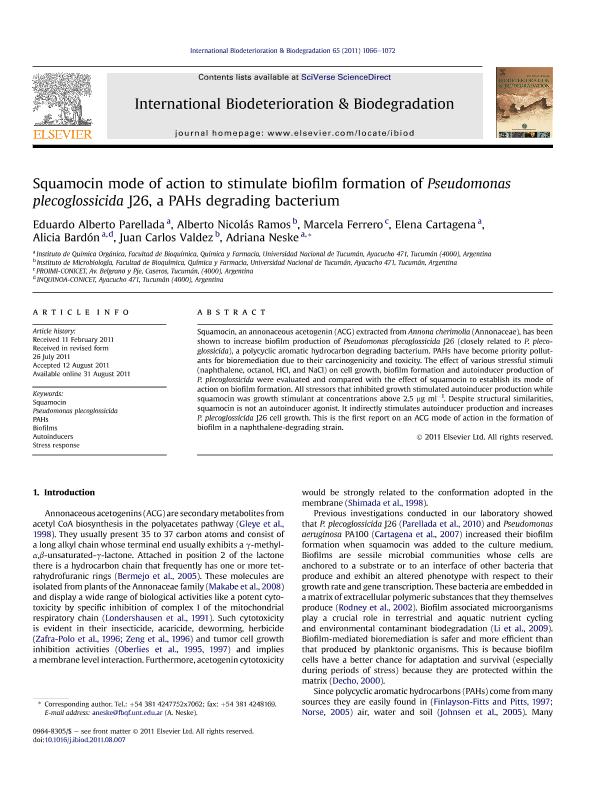Artículo
Squamocin mode of action to stimulate biofilm formation of Pseudomonas plecoglossicida J26, a PAHs degrading bacterium
Parellada, Eduardo Alberto ; Ramos Vernieri, Alberto Nicolás
; Ramos Vernieri, Alberto Nicolás ; Ferrero, Marcela Alejandra
; Ferrero, Marcela Alejandra ; Cartagena, Elena; Bardon, Alicia del Valle
; Cartagena, Elena; Bardon, Alicia del Valle ; Valdéz, Juan Carlos; Neske, Adriana Neske
; Valdéz, Juan Carlos; Neske, Adriana Neske
 ; Ramos Vernieri, Alberto Nicolás
; Ramos Vernieri, Alberto Nicolás ; Ferrero, Marcela Alejandra
; Ferrero, Marcela Alejandra ; Cartagena, Elena; Bardon, Alicia del Valle
; Cartagena, Elena; Bardon, Alicia del Valle ; Valdéz, Juan Carlos; Neske, Adriana Neske
; Valdéz, Juan Carlos; Neske, Adriana Neske
Fecha de publicación:
09/2011
Editorial:
Elsevier
Revista:
International Biodeterioration and Biodegradation
ISSN:
0964-8305
Idioma:
Inglés
Tipo de recurso:
Artículo publicado
Clasificación temática:
Resumen
Squamocin, an annonaceous acetogenin(ACG) extracted from Annona cherimolia (Annonaceae). has been shown to increase biofilm production of Pseudomonas plecoglossicida J26 (closely related to P. plecoglossicida), a polycyclic aromatic hydrocarbon degrading bacterium. PAHs have become priority pollutants for bioremediation due to their carcinogenicity and toxicity. The effect of various stressful stimuli (naphthalene.octanol, HCl, and NaCl)on cell growth, biofilm formation and autoinducer production of P. plecoglossicida were evaluated and compared with the effect of squamocin to establish its mode of action on biofilm formation. All stressors that inhibited growth stimulated autoinducer production while squamocin was growth stimulant at concentrations above 2.5 ug/ml. Despite structural similarities, squamocin is not an autoinducer agonist. It indirectly stimulates autoinducer production and increases P. plecoglossicida J26 cell growth. This is the first report on an ACG mode of action in the formation of biofilm in a naphthalene-degrading strain.
Palabras clave:
Squamocin
,
Pseudomonas Plecoglossicida
,
Pahs
,
Biofilm
,
Autoinducers
,
Stress Response
Archivos asociados
Licencia
Identificadores
Colecciones
Articulos(CCT - NOA SUR)
Articulos de CTRO.CIENTIFICO TECNOL.CONICET - NOA SUR
Articulos de CTRO.CIENTIFICO TECNOL.CONICET - NOA SUR
Articulos(INQUINOA)
Articulos de INST.DE QUIMICA DEL NOROESTE
Articulos de INST.DE QUIMICA DEL NOROESTE
Articulos(INSIBIO)
Articulos de INST.SUP.DE INVEST.BIOLOGICAS
Articulos de INST.SUP.DE INVEST.BIOLOGICAS
Articulos(PROIMI)
Articulos de PLANTA PILOTO DE PROC.IND.MICROBIOLOGICOS (I)
Articulos de PLANTA PILOTO DE PROC.IND.MICROBIOLOGICOS (I)
Citación
Parellada, Eduardo Alberto; Ramos Vernieri, Alberto Nicolás; Ferrero, Marcela Alejandra; Cartagena, Elena; Bardon, Alicia del Valle; et al.; Squamocin mode of action to stimulate biofilm formation of Pseudomonas plecoglossicida J26, a PAHs degrading bacterium; Elsevier; International Biodeterioration and Biodegradation; 65; 7; 9-2011; 1066-1072
Compartir
Altmétricas



